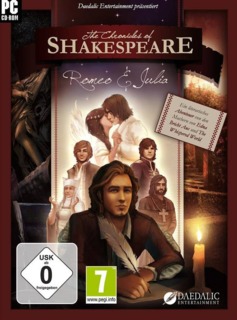INTRO:
Daedalic Entertainment is not afraid to try to new things. However, boldness does not always lead to success. The Chronicles of Shakespeare was an example of such a decision which has not turned out well.
There are not a lot of games which utilize Shakespeare’s plays; Daedalic Entertainment tries to fill this niche. However, although the Chronicles of Shakespeare may pay good homage to the affable writing of the venerable playwright, its actual gameplay is boring, tedious and sometimes broken.
PREMISE:
The premise of the game involves a likely fictitious portrayal of Shakespeare’s younger years; the impression of fictitiousness might come to those who scrutinize the presence of other characters in the game and compare these details against the historical accounts of the real-world persons whom these characters represent.
Doubts of authenticity aside, Shakespeare has earned himself the patronage of a lord of House Stanley. Said lord has gotten him the job of a playwright in a theatre. He is working on the script for Romeo and Juliet.
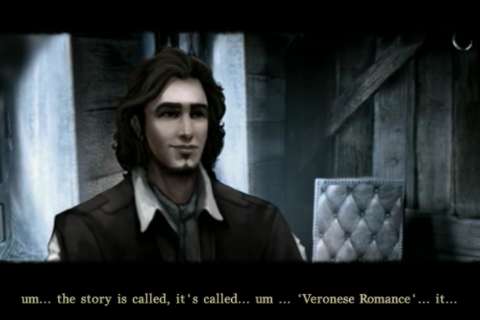
Writer’s block was about to set on Shakespeare’s head when his patron lord decides to have his young daughter Anne drop by in the evenings to listen to his scripts. Anne would happen to be both a critic of his work-in-progress and his muse.
(This “Anne” is “Anne Stanley”, though whether she is an actual associate of Shakespeare or not in real life is debatable.)
One of the main appeals of the game is to listen to Anne’s and Shakespeare’s remarks on the script, particularly how Shakespeare would fill in holes in the plot when Anne points them out.
Unfortunately, the player will not have a part in how this story-writing endeavor plays out. Rather, the player will be trust into the story of Romeo and Juliet, playing the roles of either protagonist in an alternating manner.
Even so, the player should not be expecting a typical adventure game experience which is based on the tragedy for which they are famous. Rather, the player will be helping them find hidden objects and solving the occasional logic puzzle.
SCENE-BY-SCENE GAMEPLAY:
Players who have played the sub-genre of point-&-click adventure games which involve finding hidden objects would be familiar with the gameplay of Romeo & Juliet.
For the sake of the uninitiated, this sub-genre presents the player with static scenes. The player is informed of what to find within these scenes, and these things happen to be hidden in nooks and crannies.
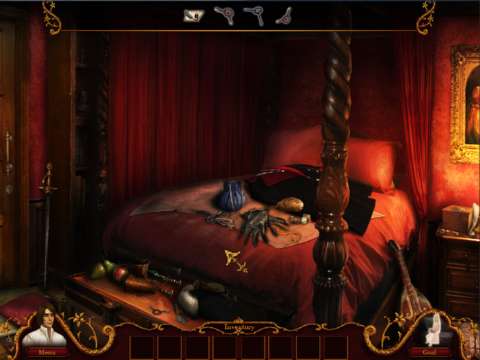
By this time, the reader (that is, you who are reading this) might have the impression that this game is a casual time-waster which is better off as a Flash game or on mobile devices. If so, you happen to be quite right; the game has been published by the likes of Big Fish Games, a casual game distributor.
(People who do not like such games are better off stopping at reading here. For others who want to know how boring such a game can get, do keep on reading.)
TEDIUM & TROPES:
Finding hidden objects can become tiresome very quickly to players who are not already (somehow) fans of such gameplay. (Such gameplay is, by the way, no more sophisticated than the irritating trend of pixel-hunting in incompetently designed adventure games of the 1990s.)
Of course, one can argue that this should not be an issue, because the game very much tells the player what to find by showing their sprites at the top of the screen. However, the objects which the player needs to find are more often than not obscured behind other sprites, to the point of being barely noticeable.
The story-writing comes up with all kinds of excuses to have the player hunting for objects. Most of these excuses are, arguably, believable, but some can seem so incredibly convenient, such as raising the water level of a basin so as to float a bunch of leaves, upon which rests a metal medallion that would have sank in the water otherwise.
Yet, the believable excuses do not make object-hunting any less tedious either.
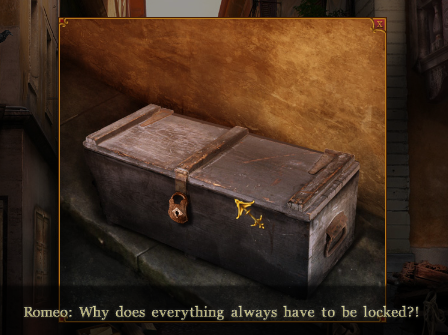
OTHER PUZZLE DESIGNS:
Fortunately, the player is not always hunting for objects in every scene; there are other kinds of puzzles which are less banal. Yet, these will not seem particularly refreshing to any player who is already experienced at puzzle-solving games.
There are puzzles about sliding tiles. These puzzles have the player slide tiles around a grid of limited space, typically with one tile missing in order to make the sliding possible and not entirely constrained. Typically, these puzzles are used to have the player form murals in order to unlock some hidden area or secret compartment.
Then, there are puzzles which have the player toggling on a cell in a grid but toggling off the adjacent cells. Typically, the player needs to set all cells to a single status in order to progress.
Next, there are puzzles which have the player overlapping pictures to form a pattern.
At the very least, these familiar puzzles relieve the tedium of finding hidden objects, but only for a while. (The player still has to find some hidden objects before he/she can begin to attempt these puzzles anyway.)
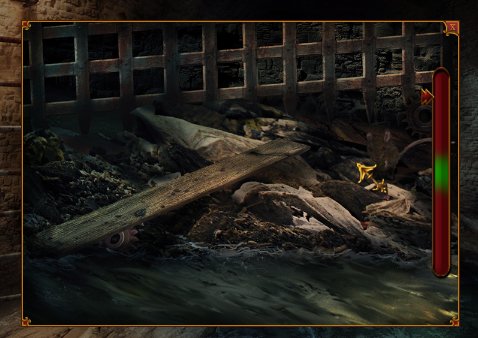
BUGGED PUZZLE:
Unfortunately, there is a puzzle in the game which is broken, and it remains broken to this day; it appears that Daedalic has never noticed this buggy puzzle.
This puzzle involves the balancing of a scale, after one of its pans has been returned to the scale. Unfortunately, the player cannot seem to interact with the weights; clicking furiously on them does nothing.
Thus, the only way forward is to click on Anne’s icon and then agreeing to solve the puzzle right away. However, the programming for the “solution” itself is broken; the sprites for the scale are messed up, and the player does not get to progress.
Fortunately, the player does get to interact with the weights after this; double-clicking on the sprite for a weight attaches the sprite to the cursor.
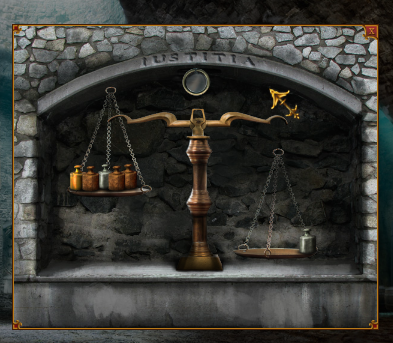
HINT SYSTEMS & OTHER CONVENIENCES:
For all the tedium, typical familiarity and bugs which the player has to contend with, there are at least some conveniences in the game which help the determined player persevere through what passes for ‘gameplay experience’ in this game.
The most obvious of these is the list of icons which appear at the top of the screen. Even if the protagonist does not seem to be able to know what needs to be found, the game will tell that to the player anyway. This is convenient, but not believable.
The developers of the game do happen to realize when an object is just too obscured to be seen. In these cases, the locations which the player needs to click on happen to sparkle. This does not happen often, but when it does, skeptical players might raise their eyebrows at how cheap this work-around is.
Finally, there is the representation of Anne, which occurs at the bottom right of the screen. Anne acts as a hint-giver when she is clicked on, but after “using” Anne, she goes back to reading. She ignores the player for a while until she closes the book (with an audible sound and an additional tinkling flourish) and looks at the player again.
Players who cannot be bothered with the gameplay but want to watch the cutscenes can use this feature to speed things along.
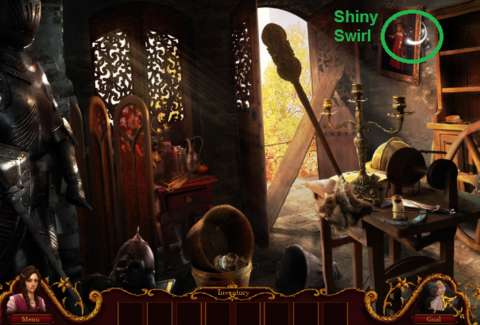
STORY PROGRESSION & LIBERTIES TAKEN:
The fictitious representation of Shakespeare and the circumstances which he is in are not to be taken seriously. If the player does research on the characters other than Shakespeare, he/she would find that not all of them are unanimously believed by historians to have been associated with the playwright; chief of these characters are the members of the House of Stanley, namely Anne, her father (Ferdinando Stanley) and her uncle (William Stanley).
Daedalic does not seem to be deeply concerned about the authenticity of these characters in the game. They are primarily used to represent Shakespeare’s circle of supporters and detractors within the story. There will be more elaboration on them later.
As for Romeo Montague and Juliet Capulet, their story remains unchanged; they are doomed to die dramatic and tragic deaths. However, their story has been manipulated to include doles of excuses to have them searching for objects.
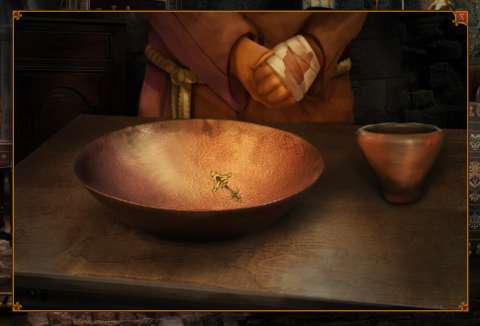
CHARACTER DESIGNS & LIBERTIES TAKEN:
Daedalic takes many liberties with how the historical characters look too.
Granted, no one alive knows exactly how Shakespeare, Ferdinando Stanley, Anne Stanley and William Stanley looked like. Even real-life painted portraits of them could have been little more than the impressions or embellishments of artists, if one is to be skeptical and/or cynical.
Regardless, Daedalic’s own impressions of the characters are pleasing to the eyes. Shakespeare may have come from a background of peasantry, but his fashion sense would have been top-of-the-line for one who was a peasant.
Similarly, Ferdinando is an incredibly good-looking middle-aged fop, whereas William Stanley could perhaps be the most dashing-looking stern gentleman whom the player would ever see in a game. As for Anne, let’s just say that Daedalic is no stranger to creating sweet and clever young ladies.
There are more to them than just looks of course; they have great voice-overs too, which will be described later.
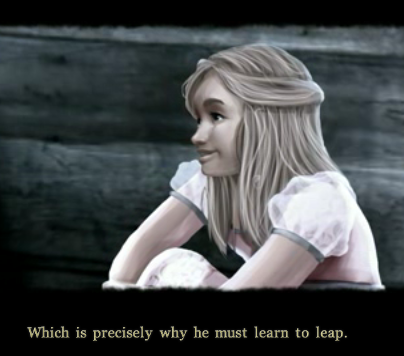
As for Romeo, Juliet and the other characters in Shakespeare’s play, they are fictitious people, so there will not be complaints about their authenticity in this review.
It should suffice to say though that if Daedalic had been looking for an opportunity to create what it thinks are the prettiest and most foppish artistic portrayals of Shakespeare’s characters, then it has made use of that opportunity.
SOME POOR TRANSLATION:
Daedalic Entertainment is a Germany-based game developer. Although there are people in Daedalic who are indeed fluent in English, such as its founders, Daedalic does not always assign the most competent person to do the translation which is needed to adapt the writing to audiences who speak other languages.
In the case of this game, the translation for the voice-over scripts in the cutscenes is impeccable; this will be elaborated later.
However, the same cannot be said about the text for the monologues of the fictitious characters. Their monologues are not as florid and witty as the text for the cutscenes. More importantly, some of them appear to have been translated poorly.
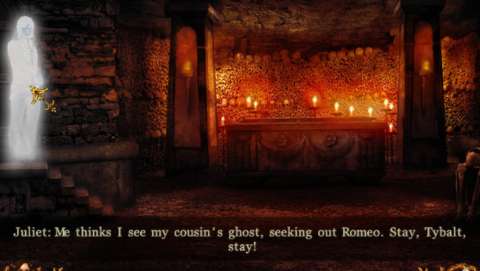
VISUAL DESIGNS:
That the characters in the game look pretty, dashing and foppish has already been mentioned earlier. Incidentally, people who follow Daedalic’s works may notice that the artstyle for the characters in this game happens to be a bit similar to those in the Dark Eye: Chains of Satinav.
Considering that this later Daedalic game happens to be of a better caliber than this one, this similarity would have been a blessing because it meant that the artstyle matured in time for that later game.
Anyway, the characters in this game may look good, but they suffer from limited frames of poses and next to no animation. Their positions during cutscenes also happen to be awkward, e.g. conversing characters are often not facing each other.
The artwork for them is also reused over and over, adapted in minor ways to fit scenes. This suggests laziness on Daedalic’s part.
The artwork for the environments in the scenes is as pretty as that for the characters. The villas of the Capulets and Montagues are particularly glamorous, as befitting the estates of influential and wealthy houses (albeit fictitious ones).
Unfortunately, their prettiness is marred by the fact that they are used for the boring gameplay of finding hidden objects. The gameplay can distract the player from their aesthetic qualities.
The scenes are mostly static. There are a few animations, but they are rather cheaply done, much like those in Flash apps.
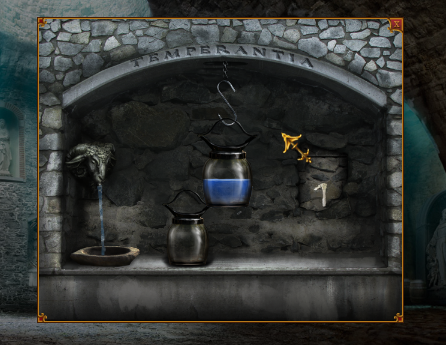
SOUND DESIGNS:
The most prominent sounds which the player listens to while playing this game are the music and voice-overs. There are other sounds, such as the sound effects which play when the player completes puzzles, but these take a proverbial backseat to the music and voice-overs.
The best music tracks in the game are those heard in cutscenes. These add some flavor to the otherwise visually displeasing scenes, which recycles character sprites in manners as had been mentioned earlier. The scenes with actual gameplay do not have music which is as impressionable as those in the cutscenes, but at least the music in these will not distract the player when he/she is searching for hidden objects.
(However, it will not prevent a bored player from falling asleep.)
The voice-overs, which occur only in the cutscenes, are the best aspect of the audio designs in the game. However, only the characters which are based on real-life people are voiced.
Each of these characters is given pleasant British-accented voice-overs for the English version of the game; whether they are authentic with respect to Shakespeare’s time is another issue of course.
Yet, it would be a rare player indeed who finds the characters’ voice-overs irritating or boring.
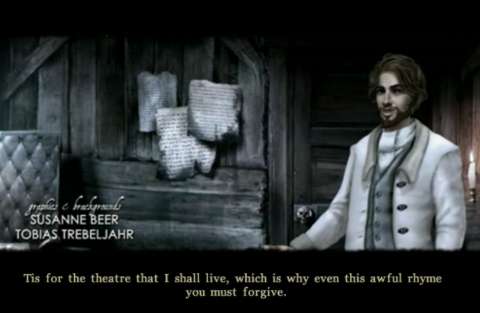
CONCLUSION:
Chronicles of Shakespeare could have been more than it is. It could have been a bold re-telling of the tale of Romeo and Juliet. It could have been an adventure game which fleshes what happened between the star-crossed lovers’ meeting and their tragic end.
Instead, Daedalic had created nothing more than a typical game about finding hidden objects, if only to jump aboard a fad bandwagon of hidden-object games in the mobile device and browser game scenes at the time.
Years on, the game has shown that its gameplay is outdated, boring and tedious. Only its pretty artwork and splendid voice-overs prevent it from being a shamelessly lackadaisical portrayal of Shakespeare’s famous tragedy.
